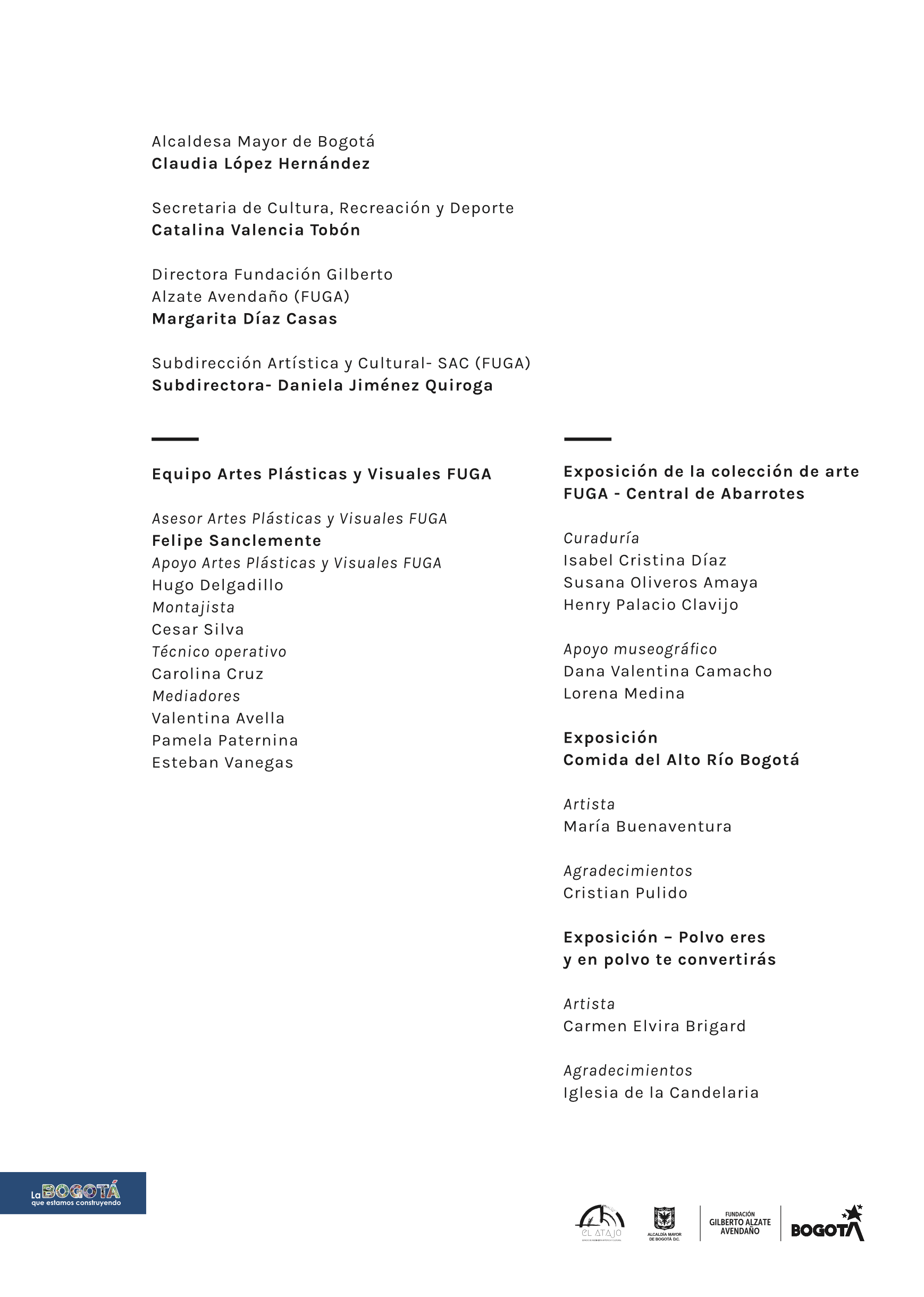An Exhibition of the FUGA Art Collection
A curatorial project of:
– Henry Palacio Clavijo (artist and manager with a master’s degree in Art and Environment from the Autonomous University of Mexico)
– Isabel Cristina Díaz (historian, art critic and professor at the Jorge Tadeo Lozano University)
– Susana Oliveros Amaya (artist and art historian, MFA from Rhode Island School of Design)
Grocery center
In the cellar the collection seems like a mass of meaning, an indistinguishable volume composed of other volumes, a miscellany of diverse capitals made of bodies that accumulate waiting to be named, differentiated and ceremonially summoned to be presented and exhibited.
The cellar of a collection is a space in which objects are treasured as a way of artificially stopping the passage of time and showing an apparent indifference to everything that surrounds, maintains and conserves it. This archive is governed by its own logic, since things may or may not be arranged to be seen, but almost always to be found. Sorting, naming and cataloging then accounts not so much for what one possesses, but for who and from where it is done.
Belonging to a collection means having a name, it means having a certain value, one that increases with each new object that is added to the set. However, in the art collection, value does not seem to depend exclusively on the things hoarded there – or accumulated – but on the words assigned to those things. Selecting a work to be part of a collection also means choosing the name of the person who produced it. A collection is also a list of names that are treasured.
The collection of the Gilberto Alzate Avendaño Foundation alludes to the history of its halls, awards, exhibitions, subjects and programs that in some way move between the anecdotal and the institutional and that give an account, like souvenirs, of the very nature of this institution. A collection in which things paradoxically stop circulating, at the same time that they come up against legal protocols that prohibit their exhibition. The dynamics of FUGA respond to self-referential processes, the constant reaffirmation of a historical legacy that is experienced as at risk of disappearing from collective cultural memory. This space constantly invites us to investigate it, to rethink it and to reinterpret it, as if the multiplicity of meanings and resignifications granted it a constant renewal of its past.
Studying the art collection of a district institution means, among other things, thinking about collecting as a representational impulse that responds to a conception of artistic practices inevitably associated with cultural policies written from the administrative programs in place. Collecting from the institution is above all a heritage practice, a process that recontextualizes images in the officialization of discourses. Thus, institutions build their collection from a supposed depoliticization of aesthetics; however, collecting objects also configures a colonial device that is precisely narrated in that official history.
Central de Abarrotes conceives FUGA and its drive to build and consolidate a collection as an institutional practice in which, in addition to the historical value of the works collected there, the need for self-legitimation is at stake. When we are invited to think about the collection through an exhibition, we were unaware of the legal status of the majority of the objects housed there: the works cannot be exhibited. If for a moment we reverse this impossibility of showing the objects by naming the artists who produced them, and these were presented to us outside of their packaging, what type of collection could we present? What stories would this set of pieces tell without authors? What would be that which disappears in the face of any of these impossibilities? On this occasion, the representational privilege of the image is what is denied. “Every representation is presented representing something.” Not as an idea, nor as a symbolic abstraction, but related to the history of an institution in which the representation of one’s name, even after 50 years, remains open.
The basement, wall, red curtains, video installation, desire, jaw, white background, black letters, masculine, polychrome silkscreen, entertainment, circulation, languages, structure, graphic, printed images, province, empire, beggars, inhabited by animals and by beggars, showcase, butts, winners, drawing, iron, steel and welding, geometry, fragility, gravity, iron sheets, history of the place, political device, memory, national stories, awards, acquisition, first exhibition, the basement, audience, room, public, sound and light, projects, lines of work, continuity, long, career, modern, housing, bees, masters, myth, organic forms, ego, series and pieces, cutouts, assemble, spray paint, humor, domestication, exhibition, demolition, song, audio track, drinking rum, rice paper, popcorn, nuclear plants, electronics, participated, experimental, first artist, career, ten minutes, young people, filmographic, award-winning, cement, plastic buckets, tights, nylon mesh, hanging, organic, abstract, grass, corn, time, growth, chocolate, white wood, bronze, about this hair, official, commemorative, population, bushes, airbrushes, irons, market, decorating thousands of Colombian homes, pastels and watercolors, feed, abyss, tribute, print, lithographic, gold letters, frame, town, individual exhibition, large format, poster, I stuffed some pants, sawdust, wrapped, plaster bands, movement, liner in resin, polished, it is not explained how it got to the leather, its own material, porcelain, resin, honorable mention, contest, making, professional artist, screams, screens, televisions, dark, ambient sounds, carving, mix sources, acrylic, metal , Devil
DUST YOU ARE AND INTO DUST YOU WILL BECOME By Carmen Elvira Brigard






